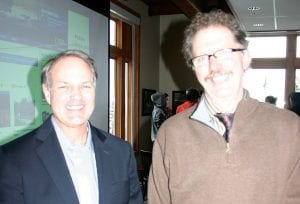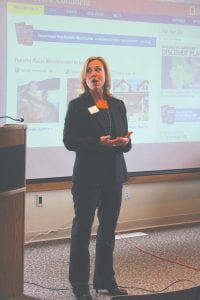Above: James Dion (left) of the National Geographic Society and Frank Jewel, a St. Louis County commissioner, were on hand last week to help unveil the Heart of the Continent geotourism website in Grand Portage. Left: Visit Cook County Executive Director Linda Kratt also spoke, calling the new website an exciting vehicle to help promote not only Cook County, but the entire region.

A packed house raptly listened as the Grand Portage Stonebridge Singers opened the event celebrating the launch of the world’s newest National Geographic geotourism site at the Grand Portage National Monument on March 20.
“Public land managers started this,” said St. Louis County Commissioner Frank Jewel, who was on hand to introduce the agenda and speakers to the people attending the unveiling of the National Geographic geotourism map and website for the Heart of the Continent region.
It was a process that began more than two years ago and now involves 90 partners, said Jewel. Those partners encompass units of government large and small, business and environmental groups, mining interests, colleges, lodges, and tourism groups, all searching working together to promote the 5 million acre Heart of the Continent, Jewel said.
Jewel introduced Grand Portage Tribal Council Member John Morrin as the first speaker.
Morrin said his mother’s family was from Grand Portage; his father’s family was from Red Cliff [Bayfield area]. “Both beautiful places. I learned from a young age that everything that was created, water, rocks, trees, has a spirit. We have to honor that spirit.
“We are stewards of the land. We have a big responsibility. We are living beings that were put here to be stewards on earth. I see Heart of the Continent as doing that. Heart of the Continent comes in and reinforces what we are doing here.
“If we take care of the earth it will take care of us,” he said.
“What’s so special about your place?” asked James Dion, Director of Tourism Programs, Maps Division for National Geographic Society. “Since the project was launched in February 2014 more than 400 individuals have added many points of interest to the website, from historic, cultural and natural landmarks to events and attractions that show off the region’s character and beauty. People from Paris, Texas to Paris, France will be able to go to the website www.traveltheheart.org and learn about Heart of the Continent.”
Dion also urged the audience to download the mobile app from the website.
The Heart of the Continent partnership includes 90 organizations in Ontario and Minnesota. This diverse group ranges from the U.S. Forest Service, universities and colleges, to area Chamber of Commerces, county boards, historical societies, mining companies, environmental groups and outdoor learning centers, to name a few entities that have joined hands to promote the area.
Since 2006 National Geographic has worked with other communities worldwide to develop geotourism map guide and websites projects, said Dion. Some of those sites have been developed in Newfoundland, Portugal’s Douro Valley and the Western Balkans. All told there are 22 geotourism programs worldwide.
The Heart of the Continent stretches from the outer boundaries of Duluth to the North Shore of Lake Superior to Thunder Bay and Sleeping Giant Provincial Park, then west to International Falls/Fort Francis and south along St. Louis County’s western border.
At more than 5 million acres, Heart of the Continent has more public green space than any other area in the center of North America.
While the primary goal is to promote economic growth and support cultural empowerment, it has other goals as well: build awareness of land and support for public lands; share resources to benefit public lands and communities; promote scientific research and its applications, and develop an identity for the region as a whole.
The Heart of the Continent geotourism website, said Dion, will evolve and change as time goes on. New photos and short videos will be added as they come in.
He also said it was “the most expensive way to make a website possible. We could have flown in a couple of National Geographic photographers and made a website in a couple of days, but we wanted input from the public about what makes your places so special.”
This unique approach to building a website was time-consuming but demonstrates the way many diverse groups could come together and work to create something of benefit for the region, he said.
“This will demonstrate the importance and the sense of place that can be shared with people from around the world,” Dion added.
Heart of the Continent will also allow creative ways and opportunities for groups to work together in new ways that can benefit the lakes, forests, wildlife and people, Dion said.
Judy Ness, Recreation Specialist for the U.S. Forest Service, spoke about the Forest Service’s place in the project. She said the Forest Service oversees 3 million acres of public land, including 1 million acres in the Boundary Waters Canoe Area Wilderness, which help make up Heart of the Continent.
Ness rattled off the number of campgrounds available, both rustic and modern for campers, the 1,900 miles of trails for hiking, biking, and motorized and non-motorized vehicles, the lakes and streams available for boating and canoeing and fishing, and said the Forest Service was happy to be part of this endeavor.
Visit Cook County Director Linda Kratt’s message to the crowd was brief, but to the point. “We are happy to be a part of this. We are blessed, very blessed to call the Heart of the Continent our home.”



Leave a Reply